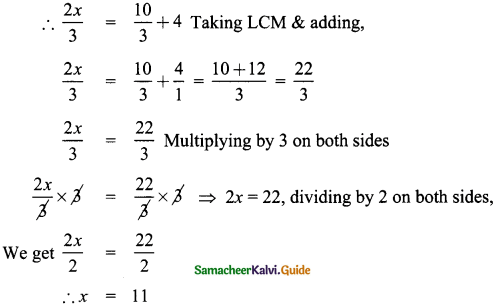Tamilnadu State Board New Syllabus Samacheer Kalvi 8th Maths Guide Pdf Chapter 6 Statistics Ex 6.1 Text Book Back Questions and Answers, Notes.
Tamilnadu Samacheer Kalvi 8th Maths Solutions Chapter 6 Statistics Ex 6.1
Question 1.
Fill in the blanks:
(i) Data has already been collected by some other person is ________ data.
Answer:
Secondary
![]()
(ii) The upper limit of the class interval (25-35) is ________ .
Answer:
35
(iii) The range of the data 200, 15, 20, 103, 3, 196, is ________ .
Answer:
197
(iv) If a class size is 10 and range is 80 then the number of classes are ________ .
Answer:
8
(v) Pie chart is a ________ graph.
Answer:
circular
![]()
Question 2.
Say True or False:
(i) Inclusive series is a continuous series.
Answer:
False
(ii) Comparison of parts of a whole may be done by a pie chart.
Answer:
True
(iii) Media and business people use pie charts.
Answer:
True
(iv) A pie diagram is a circle broken down into component sectors.
Answer:
True
![]()
Question 3.
Represent the following data in ungrouped frequency table which gives the number of children in 25 families.
1, 3, 0, 2, 5, 2, 3, 4, 1, 0, 5, 4, 3, 1, 3, 2, 5, 2, 1, 1, 2, 6, 2, 1, 4
Answer:
The data given is raw data.
Ascending order : 0, 1, 2, 3, 4, 5, 6

∴ Tabulating in frequency distribution table we get

![]()
Question 4.
Form a continuous frequency distribution table for the marks obtained by 30 students in a X std public examination.
328, 470, 405, 375, 298, 326, 276, 362, 410, 255, 391, 370, 455, 229, 300, 183, 283, 366, 400, 495, 215, 157, 374, 306, 280, 409, 321, 269, 398, 200.
Answer:
Maximum mark obtained = 495
Minimum marks obtained = 157
Range = Maximum value – Minimum value
Range = 495 – 157
= 338
If we take the class size as 50 then the number of class intervals possible
![]()
= \(\frac{338}{50}\) = 6.76
≅ 7
![]()
The percentage difference calculator is here to help you compare two numbers.
Question 5.
A paint company asked a group of students about their favourite colours and made a pie chart of their findings. Use the information to answer the following questions.
(i) What percentage of the students like red colour?
(ii) How many students liked green colour?
(iii) What fraction of the students liked blue?
(iv) How many students did not like red colour?
(v) How many students liked pink or blue?
(vi) How many students were asked about their favourite colours?

Answer:
Total percentage of students = 100 %
∴ 50students = 100% – (30% + 20% + 25% + 15%)
= 100% – 90%
50 students = 10%
10% of total students = 50
∴ \(\frac { 10 }{ 100 }\) (Total students) = 50
Total students = \(\frac{50 \times 100}{10}\) = 500.
Total students = 500.
(i) 20% of the students like red colour.
(ii) 15% of the students liked green colour.
\(\frac{15}{100}\) × 500 = 75 students liked green colour.
![]()
(iii) 25% students liked blue students liked blue.
⇒ \(\frac{25}{100}\) students liked blue.
⇒ \(\frac{1}{4}\) students liked blue.
(iv) Percentage of students liked red colour
= 20%
Percentage of students did not like red colour
= 100% – 20%
= 80%
∴ Number of students did not like red colour
= 80% of 500
= \(\frac{80}{100}\) × 500 = 400
400 students did not like red colour.
(v) Students liked pink or blue = students liked pink + students liked blue.
= 30% of 500 + 25% of 500
= \(\frac{30}{100}\) × 500 + \(\frac{25}{100}\) × 500
= 150 + 125
= 275
![]()
(vi) Total number of students = 500
500 students were asked about their favourite colour.

Question 6.
A survey gives the following information of food items preferred by people. Draw a Pie chart.
![]()
Answer:
Total number of people = 160 + 90 + 80 + 50 + 30 + 40 = 450
Converting the number of people prefer various food items into components part of 360°


Food items are preferred by people.

![]()
Question 7.
Income from various sources for Government of India from a rupee is given below. raw a pie chart.

Answer:

Income from various sources for Government of India in a rupee.

![]()
Question 8.
Monthly expenditure of Kumaran’s family is given below. Draw a suitable Pie chart.

Also
1. Find the amount spent for education if Kumaran spends ₹ 6000 for Rent.
2. What is the total salary of Kumaran?
3. How much did he spend more for food than education?
Answer:

Monthly expenditure of kumaran’s family.

1. Given Kumaran spends ₹ 6000 for Rent.
∴ 15% of’ total expenditure = 6000
\(\frac{15}{100}\) (Total Expenditure) = 6000
Total Expenditure = \(\frac{6000 \times 100}{15}\)
Total Expenditure = ₹ 40,000
Amount spend l’or education = 20% of total expenditure.
\(\frac{20}{100}\) × 40,000
= ₹ 8000
![]()
2. Total salary of Kumaran = ₹ 40,000
3. Amount spend for food = 50% of (40,000)
Amount spend for the food than education
= 20,000 – 8,000
= ₹ 12,000























































































